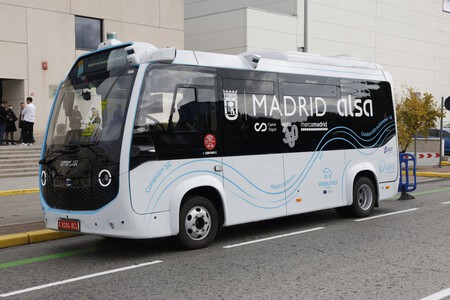Something is changing in Mercamadrid, and it is not just the rhythm of trucks that enter and leave from the first hour. The venue has taken another step towards the future with the entry onto the scene of a minibus capable of moving without depending on the direct control of a driver. The image may surprise even those who know this place well, an enclave that operates day and night. The City Council has chosen this space to show how it wants to start testing technologies that aim to become everyday in the coming years.
Where the experiment really begins. The new Smart Urban Space turns Mercamadrid into a place to measure, with real data, how certain technologies work in urban management. The City Council has activated a pilot here included in the European project Mobilities for EU, which uses delimited areas to evaluate their impact in operational situations. In this case, mobility, efficiency and safety indicators are analyzed that will allow us to know if the solutions applied can be replicated and later scaled to other areas of the city.
Who is behind the minibus. The official note from the City Council does not specify the manufacturer of the vehicle used in the pilot, but the images released by the project partners and the material provided by Somauto suggest that it is the e-CENTRO, a model from the Turkish company Otokar. It is an electric minibus designed to operate in urban environments and has a version with level 4 autonomous driving capabilities.
The e-CENTRO is prepared to move autonomously thanks to a system that combines perception of the environment, 360-degree vision and continuous analysis of the road. This equipment allows the vehicle to plan its route and react to the elements it encounters in a limited and monitored space. In the shared material, a person can be seen in the front seat, but the official communication has not specified their function.

Vehicle numbers. The e-CENTRO is a 6.6 meter electric minibus that incorporates 110 kWh NMC Li-ion batteries installed in the floor, an arrangement that frees up interior space and allows a capacity of up to 32 passengers. Its DANA-TM4 engine delivers 100 kW (peak 200 kW) and 1,200 Nm for urban routes. According to the manufacturer, it supports a full recharge in 1.5 hours and uses a regenerative braking system that recovers up to 25% of energy in urban circulation.

The concept behind the experiment The City Council defines these spaces as areas where physical infrastructure is combined with sensors, actuators and telecommunications systems connected to the City Operating System. Its function is to monitor in real time what is happening in the environment and generate data that allows urban management to be adjusted more precisely. The project also includes a Smart City Interpretation Center, designed to show citizens how these technologies work.
As we say, the pilot is part of Mobilities for EU, a consortium led by Madrid and Dresden, the German city that co-directs the project and acts as a strategic partner in its coordination. This group brings together 29 partners from nine countries and extends its tests to cities such as Espoo, Gdansk, Ioánnina, Sarajevo and Trencin.
It involves transport operators, technology companies and universities that collaborate at different levels of the project. Among the members are Alsa, PreZero, MásOrange, Ferrovial, SAP, Volkswagen, T-Systems and the Polytechnic Universities of Madrid and Dresden, along with other entities linked to the digital transition and sustainable mobility.
The roadmap and the money at stake. The City Council has framed this pilot within its Digital Transformation Strategy, a plan that reserves more than 60 million euros for different projects over the next five years. These include the contract for smart urban spaces, currently in the bidding phase, with a budget of 7.5 million and an execution period of 48 months.
Images | ALSA |
In WorldOfSoftware | A fear begins to grow in some European countries: that China will deactivate its electric buses remotely
